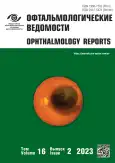Transpalpebral tonometry as a priority method for intraocular pressure monitoring in corneal pathology
- Authors: Petrov S.Y.1, Filippova O.M.1, Markelova O.I.1
-
Affiliations:
- Helmholtz National Medical Research Center of Eye Diseases
- Issue: Vol 16, No 2 (2023)
- Pages: 7-15
- Section: Original study articles
- URL: https://journals.rcsi.science/ov/article/view/253832
- DOI: https://doi.org/10.17816/OV122120
- ID: 253832
Cite item
Abstract
BACKGROUND: Measurement of intraocular pressure in the presence of combined ophthalmic condition could determine further therapy and prognosis. However, tonometry in corneal diseases could lead to unreliable results. The search for methods for intraocular pressure measurement in these settings is a critical task intended to expand diagnostic capabilities.
AIM: Evaluation of the transpalpebral tonometry diagnostic value for intraocular pressure monitoring in patients with corneal conditions of various origin.
MATERIALS AND METHODS: Measurements of intraocular pressure were carried out in 39 patients with glaucoma and/or cataract (mean age 62.34 ± 9.1), with corneal changes due to various ophthalmic conditions: post-traumatic scars; keratotomy scars as a result of refractive surgery; corneal defects due to ulcerative process of various etiology; corneal erosions; bullous keratopathy; deformities and leukomas after surgical treatment of pterygium or exposure to an infectious agent. Intraocular pressure measurement was carried out using several methods: palpation, using “rebound” and transpalpebral tonometry, in some cases tonometry was performed according to Maklakov method.
RESULTS: The averaged data were comparable: palpation; “rebound” tonometry — 23.34 ± 4.7 mm Hg; transpalpebral tonometry — 24.27 ± 4.7 mm Hg; and Maklakov tonometry — 23.16 ± 5.4 mm Hg. The accuracy and reproducibility of measurement results increased significantly with the improvement of skills in using tonometers.
CONCLUSIONS: Transpalpebral tonometry using TVGD-02 tonometer makes it possible to adequately assess intraocular pressure in patients with corneal pathology. The absence of contact during the implementation of technique makes it possible to recognize it as a priority when measuring intraocular pressure in certain categories of patients.
Full Text
##article.viewOnOriginalSite##About the authors
Sergey Y. Petrov
Helmholtz National Medical Research Center of Eye Diseases
Email: glaucomatosis@gmail.com
ORCID iD: 0000-0001-6922-0464
Dr. Sci. (Med.), Professor, head of the Department of glaucoma
Russian Federation, MoscowOlga M. Filippova
Helmholtz National Medical Research Center of Eye Diseases
Author for correspondence.
Email: changa2@mail.ru
ORCID iD: 0000-0001-9082-4537
Cand. Sci. (Med.), research associate of the Department of glaucoma
Russian Federation, MoscowOksana I. Markelova
Helmholtz National Medical Research Center of Eye Diseases
Email: Levinaoi@mail.ru
ORCID iD: 0000-0002-8090-6034
postgraduate student of the Department of glaucoma
Russian Federation, MoscowReferences
- Petrov SYu. Target IOP as a measure of glaucoma surgery efficacy. Ophthalmology in Russia. 2014;11(4):4–9. (In Russ.) doi: 10.18008/1816-5095-2014-4-4-9
- Samoylov AN, Samoylova PA, Ahmetov NR, et al. Methods for measuring intraocular pressure: disadvantages and advantages. Ophthalmology Reports. 2022;15(3):63–78. (In Russ.) doi: 10.17816/OV106140
- Greene PR, Sergienko NM, Wang SK. Review: measurement techniques for intraocular pressure. Optom Open Access. 2016;1(3):118. doi: 10.4172/2476-2075.1000118
- Dabasia PL, Lawrenson JG, Murdoch IE. Evaluation of a new rebound tonometer for selfmeasurement of intraocular pressure. Br J Ophthalmol. 2016;100:1139–1143. doi: 10.1136/bjophthalmol-2015-307674
- Meier-Gibbons F, Berlin MS, Töteberg-Harms M. Twenty-four hour intraocular pressure measurements and home tonometry. Curr Opin Ophthalmol. 2018;29(2):111–115. doi: 10.1097/ICU.0000000000000460
- Iomdina EN, Klevtsov EA, Ivanishchev KV, et al. Experimental simulation for determining optimal design parameters of a transpalpebral tonometry sensor. The Russian Annals of Ophthalmology. 2019;135(6):27–32. (In Russ.) doi: 10.17116/oftalma201913506127
- Dykin VI, Ivanishchev KV, Kornev NP, et al. Tonometr vnutriglaznogo davleniya dinamicheskogo tipa. Biomedical Engineering. 2013;(4):33–36. (In Russ.)
- Chen M, Zhang L, Xu J, et al. Comparability of three intraocular pressure measurement: iCare pro rebound, noncontact and Goldmann applanation tonometry in different IOP group. BMC Ophthalmology. 2019;19:225. doi: 10.1186/s12886-019-1236-5
- Kushnarevich NYu, Iomdina EN, Bessmertny AM, Kuzin MN. Estimation of the accuracy and informativeness of measuring intraocular pressure in patients with their contact lenses on by transpalpebral scleral tonometry. Russian Ophthalmological Journal. 2020;13(2):23–28. (In Russ.) doi: 10.21516/2072-0076-2020-13-2-23-28
- Wisse R, Peters N, Imhof SM, van der Lelij A. Comparison of Diaton transpalpebral tonometer with applanation tonometry in keratoconus. Int J Ophthalmol. 2018;9(3):395–398. doi: 10.18240/ijo.2016.03.12
- Shikha J, Ashok P, Rahul V, Punam K. Relevance of intraocular pressure measurement in ulcerative microbial keratitis. Acta Sci Ophthalmol. 2021;4(4):39–43. doi: 10.31080/ASOP.2021.04.0233
- Illarionova AR, Piletskii NG. Issledovanie dostovernosti pokazanii tonometra dlya izmereniya vnutriglaznogo davleniya cherez veko (TGDTS-01 “PRA”). Russian Journal of Clinical Ophthalmology. 2001;(2):55–56. (In Russ.)
- Filippova OM. Transpalpebralnaya tonometriya: novye vozmozhnosti registratsii vnutriglaznogo davleniya. Glaukoma. 2004;(1): 54–56. (In Russ.)
- Egorov EA, Romanova TB, Kats DV, et al. Transpalpebralnaya tonometriya — perspektivnyi metod kontrolya vnutriglaznogo davleniya. Russian Journal of Clinical Ophthalmology. 2016;(2):75–78. (In Russ.) doi: 10.21689/2311-7729-2016-16-2-75-78
- Avetisov SE, Erichev VP, Antonov AA. Diagnostic capabilities of transpalpebral tonometry with IGD-03. National Journal glaucoma. 2016;15(3):17–23. (In Russ.)
- Filippova OM, Bessmertny AM, Kuzin MN, Petrov SYu. Prospects of using the TVGD-02 tonometer for assisted monitoring of intraocular pressure at home. Russian Ophthalmological Journal. 2021;14(2):27–35. (In Russ.) doi: 10.21516/2072-0076-2021-14-2-27-35
- Vostrukhin SV, Agadzhanyan TM, Fokina ND, Sherstneva LV. Osobennosti tonometrii posle keratorefraktsionnykh operatsii. Russian Journal of Clinical Ophthalmology. 2015;15(2):77–82. (In Russ.)
- Dumitrescu O-M, Istrate S, Macovei M-L, Gheorghe AG. Intraocular pressure measurement after penetrating keratoplasty. Diagnostics. 2022;12(2):234. DOI: 10.3390/ diagnostics12020234
- Salvetat ML, Zeppieri M, Miani F, et al. Comparison of ICare tonometer and goldmann applanation tonometry in normal corneas and in eyes with automated lamellar and penetrating keratoplasty. Eye. 2011;25:642–650. doi: 10.1038/eye.2011.60
Supplementary files












